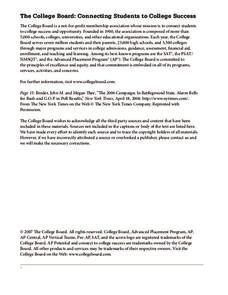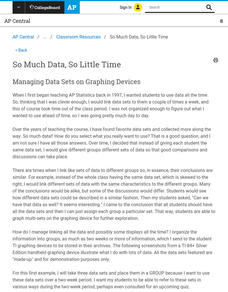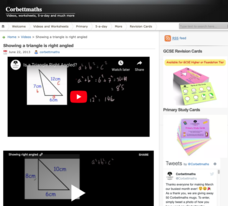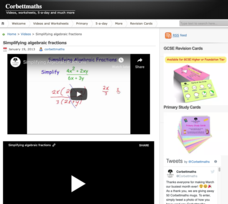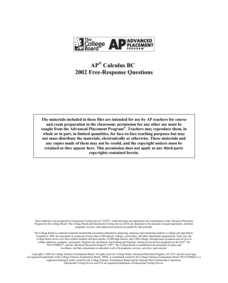College Board
2016 AP® Statistics Free-Response Questions
Test your classes on their knowledge of advanced statistic concepts. Young math scholars get a sneak peek at the end of course AP® statistics exam with the released items from the 2016 test. The six-question free response exam addresses...
College Board
2017 AP® Statistics Free-Response Questions
Reduce testing anxiety by helping learners prepare for test day. Scholars complete six free-response questions from a released AP® exam. The questions test a variety of concepts including confidence intervals, frequency tables,...
College Board
2018 AP® Statistics Free-Response Questions
Are your classes ready for their final exams? Give them a test run with the 2018 AP® exam. The resource provides the six free-response questions covering topics such as confidence intervals, population proportions, and least-squares...
College Board
Sampling Distributions
The validity of data depends on the strength of the sample. A collection of instruction and activities focuses on sampling distributions and the analysis of that data. Scholars learn about distribution tests such and Central Limit...
College Board
So Much Data, So Little Time
Organizing data in a statistics class is often a challenge. A veteran statistics teacher shares data organization tips in a lesson resource. The instructor shows how to group data to link to individual calculators in a more efficient...
College Board
Coke® Versus Pepsi®: An Introductory Activity for Test of Significance
Most people claim they can tell the difference between Coke and Pepsi. Scholars conduct a fun experiment to test that claim! Once learners collect their data, they analyze the results and determine if the statistics are significant.
College Board
Special Focus: Inference
Statistics is all about making inferences! A lesson guide explains the meaning of inferences and how to use statistics to make them. The resource provides instruction as well as information about the topic on the AP® Statistics exam.
College Board
Why Variances Add - And Why It Matters
Why is adding variance important? A lesson outline defines a variance theorem and how it affects the data statistics. The instruction shows scholars the importance of considering the variance of data and why it requires independence.
Howard Hughes Medical Institute
Population Genetics, Selection, and Evolution
The Hardy-Weinberg principle states that alleles and genotypes remain constant in the absence of evolutionary influences. Scholars complete a simple hands-on activity applying the Hardy-Weinberg principle to sample data. They observe how...
Corbett Maths
Hexagon Inscribed Within a Circle
Mark off the length of the radius around the circle. Using a compass, the presenter shows how to construct a regular hexagon in a circle. Pupils see how triangles formed in the hexagon are equilateral, allowing for the construction to...
Corbett Maths
Showing a Triangle Is Right Angled
Determine whether it is right or not. Using the Pythagorean Theorem, the video shows how to determine whether a triangle is a right triangle. Pupils practice the skill in a few of the problems in the associated worksheets on the...
Corbett Maths
Constructing Equilateral Triangles and 60 Degree Angles
Creating a 60-degree angle also creates an equilateral triangle. By watching the video, individuals learn the steps required to construct a 60-degree angle. The presentation shows that the process is the same for constructing an...
Corbett Maths
Angles in the Same Segment – Proof
If angles intercept the same arc, the angles must be the same size. The quick video talks through the proof of showing the reason two inscribed angles that intersect the same arc have the same measurement. Pupils then create their own...
Corbett Maths
Dividing Algebraic Fractions
Do the keep, change, flip dance. The resource shows that the division of algebraic fractions follows the same rules as dividing numerical fractions. Pupils understand that if they can multiply rational expressions, they can divide...
Corbett Maths
Multiplying Algebraic Fractions
Make the complicated look relatively simple. The video shows how multiplication of algebraic fractions is easier when they factor the numerators and denominators. Pupils see which factors will cancel, or divide out, easier when writing...
Corbett Maths
Simplifying Algebraic Fractions
Simplification is about factoring. While working with rational expressions, pupils must know how to factor. The video shows how the process of finding common factors in algebraic fractions is similar to finding common factors in...
Corbett Maths
Adding Algebraic Fractions
The process requires the combination of several concepts. A video shows how individuals need several concepts to add rational expressions. Pupils must remember they need to find common denominators, combine like terms, and use the...
Corbett Maths
Dividing Algebraic Expressions
Get back to the basics to become an expert. The short video shows the basics of dividing algebraic expressions. Using several examples, the presenter reminds viewers of the rules of exponents when dividing. Pupils practice dividing...
College Board
2008 AP® Calculus BC Free-Response Questions
The AP® exam is not just about the calculations. By reviewing the free-response questions from 2008, teachers and pupils see that several items require justifications and explanations to gain full credit. The chief reader even points out...
College Board
2006 AP® Calculus BC Free-Response Questions
Move along with the review. Teachers and scholars use the six released free-response questions to review for their upcoming AP® exam. Questions from the 2006 exam contain problems dealing with cars, objects moving along a curve, and...
College Board
2005 AP® Calculus BC Free-Response Questions
Differentiate between the exams. Using the Q&A document, teachers compare the free-response questions that BC test-takers see to those that AB test-takers see. The pupils see which questions come from AB content and also those that...
College Board
2004 AP® Calculus BC Free-Response Questions
Given a set of questions, pupils realize the way the Calculus BC free-response exam asks questions. The items include both contextual and non-contextual questions. Both types are split into the calculator and non-calculator sections for...
College Board
2003 AP® Calculus BC Free-Response Questions
There are shaded areas, particles, polar equations, oh my! Teachers use the materials to see how their pupils compare to the AP® Calculus BC exam expectations. Scholars use the released items to practice on several BC topics and become...
College Board
2002 AP® Calculus BC Free-Response Questions
Where do the questions come from? Individuals examine released items and see the topics included. Teachers use the materials to see the distribution between strictly BC content and that which is shared with AB. The 2002 Calculus BC is...





